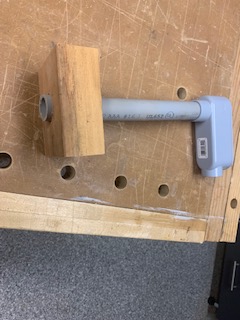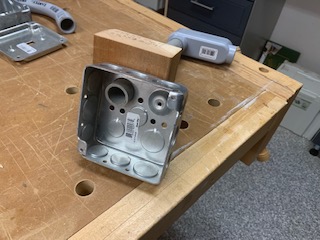You can't run Romex there at all. Romex is only rated for indoor use. Conduit outdoors is a wet location. You could use UF-B cable, which is "outdoor Romex" if you will.
Metal boxes are great, but to come into one, you need a male PVC terminal adapter and a conduit lock-nut.
Now, there are 2 ways to use conduit. We'll talk about each.
Conduit merely as a damage shield for direct-use cable (or direct-burial cable).
In this case, you're using a Romex-like cable (NM, UF, SEU, SER) that is legal to directly use inside the walls. However, you reach a point where additional protection is needed (like for UF, the transition out of the house and down into the ground).
In that case, you're using a stick or two of conduit merely as a damage shield. It doesn't even need to be electrical conduit; any metal or sufficiently stiff plastic will do, doesn't even need to be pipe-like. People tend to choose electrical conduit because it's a safe bet.
In that case, you do not need a junction box where the conduit ends, you just need to de-burr the end of the pipe and make sure it exits where it won't create a problem for the cable (i.e. it needs to end in the middle of the wall, not pinned against the interior surface where a nail through the wall could harm it).
Also, you can disregard "conduit fill" rules, which means you can use #14 and #12 UF cables in 1/2" conduit (if you can get it in there lol, good luck!)
Conduit as a wiring method
In this case, you are using conduit as it was intended. You must start and end the conduit run in a junction box (or panel), but at that junction box you can transition to another wiring method. For instance, you might bring Romex to the junction box, then run THWN wires outdoors through the "conduit as a wiring method" then transition back to Romex in the other building's junction box.
However, in the conduit run, you must follow all the rules. Thermal derate (no more than 3-4 circuits per conduit), conduit fill, limits to bends, access points etc.
As far as conduit fill, it really works best to use individual wires such as THWN or XHHW. UF cable is at a huge disadvantage - it's a very wide and flat cable, so it requires very large conduit. 12/2 and 14/2 UF need 3/4" conduit. Larger UF needs ridiculously large conduit - 6/3 UF needs 2" conduit. Really. Two 6/3 UF's need 3-1/2" conduit!
Also, THHN and XHHW wires are actually allowed more amps for the same size wire. On a 50A circuit you can use #8 instead of #6, and that can pay for the conduit!


